Round-up: 4 affordable soapbar-loaded electric guitars
Solidbodies with P-90-style pickups reviewed, compared
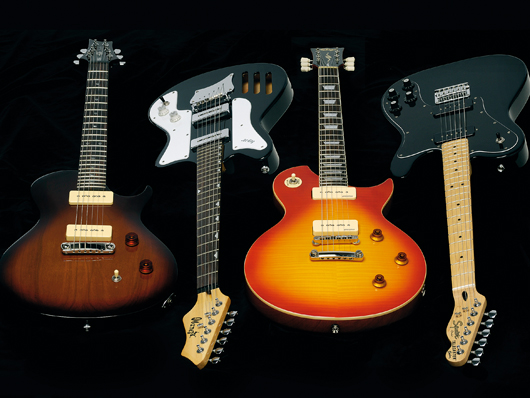
4 soapbar-loaded electric guitars with P-90-style pickups (£279-£535)
Gibson’s P-90 single-coil is one of the electric guitar manufacturing world’s oldest pickup designs. But in spite of this, it still finds itself just as valid and useful today as it was when it first went into production all the way back in 1946.
The P-90 appeared on Gibson’s very first solidbody electric in 1952, but its popularity waned with the invention of the Gibson humbucker later on in the decade, which cured the annoying hum problem of the earlier single-coil design. Since its usurping by the mighty humbucker, it’s fair to say that the P-90-style singlecoil only began to reappear in any significant numbers during the retro revival of the early nineties.
Despite this relative lack of popularity over the years, the P-90 has remained a thoroughly characterful pickup and it has proved to be a more attractive proposition for rootsier players than the highfret virtuosos. That said, it’s still trailing a long way behind the dominant pair of the humbucker and the Fender-style single-coil. As if to emphasise this unfortunate lack of popularity, the rather excellent PRS SE Soapbar we have here will actually be discontinued in 2010. Pah!
The P-90 design comes housed in two forms: the original ‘dog-ear’ style, so named because of its cover’s triangular ‘ears’ (as found on Gibson ES-175 and early Les Paul Junior models), where the only height adjustment available is from the polepieces.
The second is the most common variety, the more solidbody-friendly ‘soapbar’ - its ear-less cover resembles a bar of soap and it is height adjustable via two screws either side of the centre polepieces. Designed with a fatter, flatter coil than the later Fender single-coil Strat and Tele pickups, it features a single row of pole pieces producing a sound with more thickness than you get from a standard Strat or Telecaster single-coil, but still with that edgy attack.
Not all P-90s are created equal
A P-90 can be beautifully raw, but should still clean up nicely with application of the volume control for touch sensitive jazz tones. Of course, not all P-90s are created equal. Those with lower outputs can sound really clean and strident in the top end, while others with a higher output create a much thicker and warmer voice.
Often with a DC resistance of around 8.5k ohms, early Gibson P-90s were a lot ‘hotter’ than many modern versions and, when loaded onto Juniors and Specials, helped to create that raw, resonant tone that’s so beloved of P-90 fans. Sound-wise, many people will place the soapbar P-90 halfway between a humbucker and single-coil - and that’s not a bad way to view it. So, let’s take a look at our four modern soapbar guitars…
First up: PRS SE Soapbar price and spec
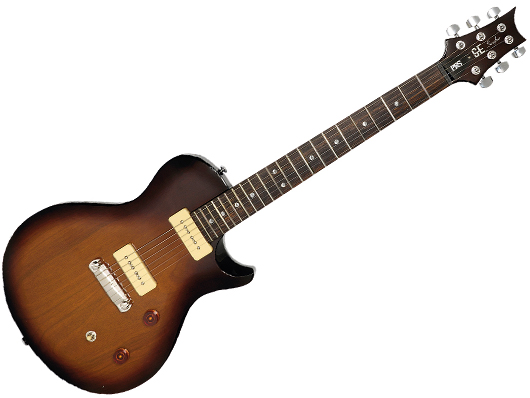
PRS SE Soapbar price and spec
Spec
Price: £535 (inc gigbag)
Origin: Korea
Body: Mahogany, single-cut
Neck: Mahogany set neck, 635mm (25-inch) scale
Fingerboard: Rosewood, moon inlays, 22 frets
Hardware: Nickel-plated PRS Stop-Tail, PRS tuners
Electrics: PRS Soapbar Treble (bridge) and Soapbar Bass (neck), volume and tone control with three-way toggle selector switch
Options: The SE Singlecut also comes with a maple top and humbuckers (£599) or a vibrato (£599)
Finishes: Tobacco sunburst (as reviewed) and vintage cherry
Next: PRS SE Soapbar build and features
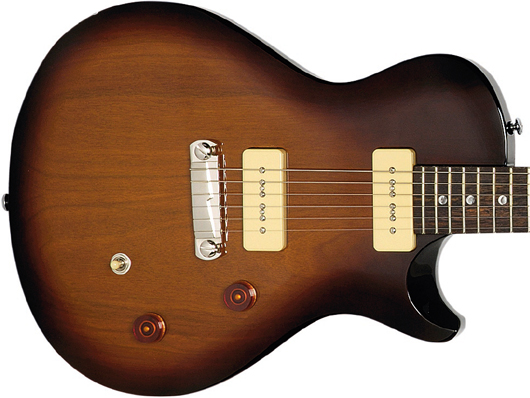
PRS SE Soapbar build and features
Build and features
This is the most expensive of our quartet (although it comes with a gigbag), but it’s the one that nails that stripped-down Les Paul Junior look. Its body is solid mahogany with a vintage-style two-tone sunburst finish.
But it’s not all traditional. The SE has PRS’s more shapely contouring across the belly and ribcage, and the controls are offset and placed closer to the bridge pickup than the traditional Gibson style.
Pickups comprise a pair of PRS Treble and Bass soapbar single-coils with vintage-y off white covers; and are controlled by a three-way toggle with master volume and tone. The Soapbar features PRS’s wide-fat neck profile married to a dark rosewood ’board that offers an excellent playing platform for the modern rocker, yet provides enough meat in the palm for traditional players.
The PRS-designed two-pin self-intonated stoptail bridge is present as usual and offers easy action-height adjustment. The PRS tuners are accurate, but a more vintage-y looking set might have been a better way to cap off a seriously well-built and cool looking guitar.
Next: PRS SE Soapbar sounds, pros and cons
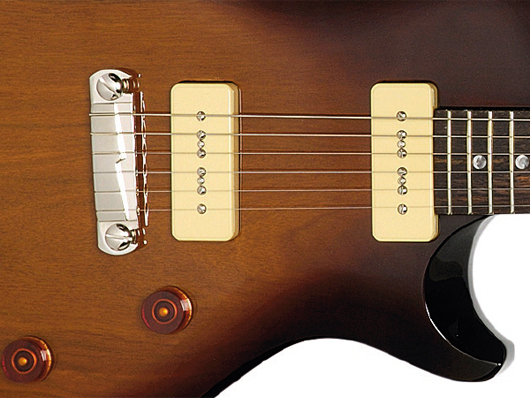
PRS SE Soapbar sounds, pros and cons
Sounds
The darker-sounding mahogany construction no doubt helps to attenuate the Soapbar’s naturally zingy top-end resonance, with the bridge pickup offering a sumptuous mid-range that gives a rich and ballsy crunch tone, the soapbar letting through just enough of the sparkling highs.
The neck pickup is similarly fat and juicy with a deep and accurate sound ideal for soft jazz inversions and is perfectly suited to angular blues chords. Single-coil hum is reasonable here; moving around tames any significant buzzes - easy to live with unless you’re OCD about that kind of thing.
Bridge pickup demo:
Pros: Unrivalled build quality; feel and tone; smart padded gigbag.
Cons: Discontinued!
4.5 out of 5
Verdict: This is one of the coolest PRS guitars and coupled with the price, build, sound quality and a gigbag, it’s a very alluring package.
Next: Ibanez JTK30H price and spec
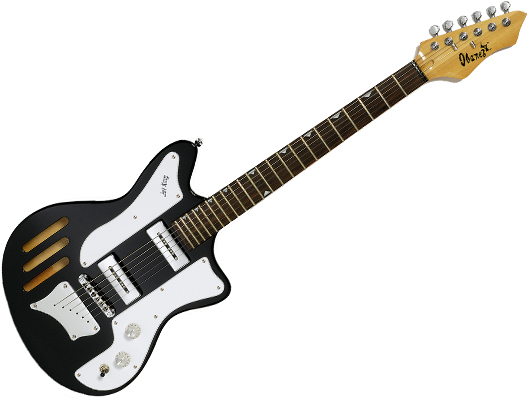
Ibanez JTK30H price and spec
Spec
Price: £285
Origin: China
Body: Mahogany, semi-hollow
Neck: Three-piece maple bolt-on, 648mm (25.5-inch) scale
Fingerboard: Rosewood with offset white inlays, 22 medium frets
Hardware: Chrome tune-o-maticstyle Full Tune III bridge, string-through plate and Ibanez tuners
Electrics: Ibanez HFS2 (bridge) and HFS1 (neck) hum-cancelling single-coil pickups, volume and tone, three-way pickup selector
Options: The JTK30 model is the solidbody version of the JTK30H (£265); the humbucking version, the JTK40, costs £295
Finishes: Black (as reviewed), turquoise
Next: Ibanez JTK30H build and features
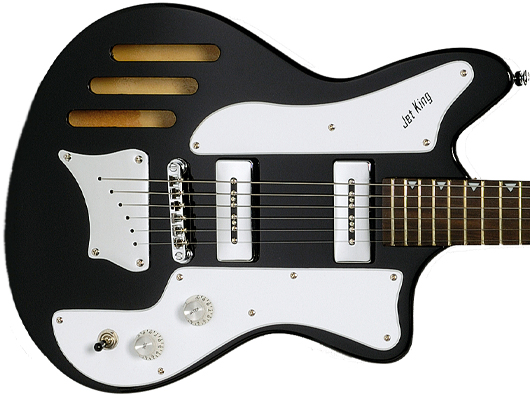
Ibanez JTK30H build and features
Build and features
For many years people have been making noise-cancelling P-90-style pickups, but it’s rare to find them on a lower budget guitar. Although they look vintage, these modern Ibanez HFS models utilise a stacked-coil design to minimise hum. They’re controlled by single volume and tone controls plus a three-way pickup selector.
The JTK30 is also unique because it not only features an offset double-cutaway body, but is the only semi-hollow design here. This construction is visible via three soundhole strips on the bass side of the mahogany body, which certainly add to its modern-retro appeal.
The sixties theme continues with a string-through chrome plate, split-wing Firebird-esque scratchplate design and shark-tooth inlays. Naturally, it’s acoustically loud, although the ultra-slim neck and modern feeling 12-inch radius fretboard seem at odds with its leftfield visual vibe. That said, the JTK30H plays solidly and looks great. A kooky headstock shape and Gibson-style control knobs cap it all off nicely.
Next: Ibanez JTK30H sounds, pros and cons

Ibanez JTK30H sounds, pros and cons
Sounds
Despite the fact the JTK30H feels less substantial than the other three, it has a surprising quality to its sound. The HFS pickups offer good P-90-style clout, but are thankfully free of hum. It’s thick and jangly all at once without being too harsh or trebly, which is perfect for choppy leads and fat chords.
Working with the volume control offers some fruity jazz tones and even reveals a fair bit of bluesy soul. With more gain, the JTK really gets mean. Traditional players will enjoy the thick blues-rock tones, while more modern players will appreciate the overall playability.
Bridge pickup demo:
Pros: Unique looks; price; tonal variety; playability.
Cons: Retro looks won’t charm everybody.
4 out of 5
Verdict: An unusual model from Ibanez that offers retro-versatility with a style all its own - all coupled with good build quality and value for money.
Next: Squier VM Tele Custom II price and spec
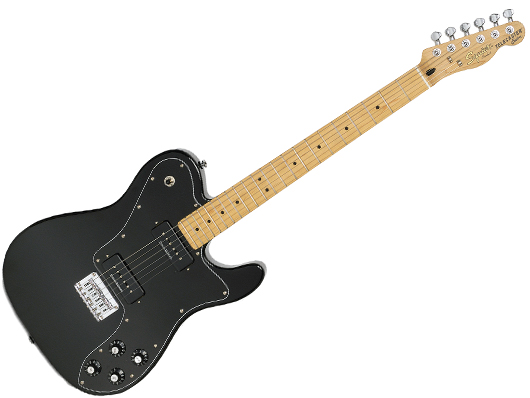
Squier VM Tele Custom II price and spec
Spec
Price: £279.99
Origin: China
Body: Agathis
Neck: Maple, ‘C’-shape, 648mm (25.5-inch) scale length
Fingerboard: Maple, black dots, 22 medium jumbo frets
Hardware: Six-saddle string-through Tele bridge, standard tuners
Electrics: Two Duncan Designed P-90-2s with Alnico V magnets, threeway selector; two volumes; two tones
Options: The VM Custom is also available with humbuckers (from £349)
Finishes: Black (as reviewed) and blonde
Next: Squier VM Tele Custom II build and features
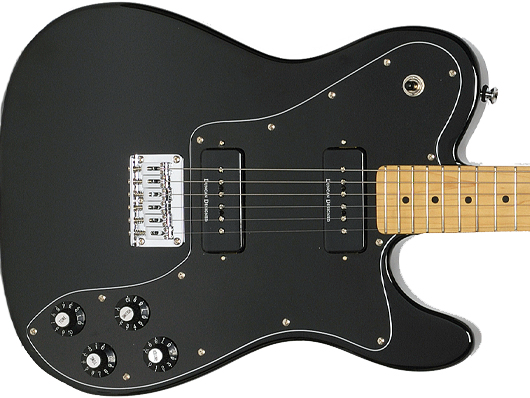
Squier VM Tele Custom II build and features
Build and features
We’ve already reviewed and admired the Squier Telecaster Custom II (as have you - check out your list of the best electric guitars under £300) and we can happily report that it’s still great - the neck is a nice ‘C’-shape, the finishing is top-notch and the vintage/modern aesthetic is spot-on. We’ve found these Vintage Modified Squiers to be consistently well-built, great sounding guitars.
The Custom II has been tweaked slightly, though. We have a pair of Duncan Designed P-90-style pickups, with Deluxe-style independent tone and volume controls and a large Tele Deluxe-like scratchplate.
Other specs include a vintage Fender 184mm (7.25-inch) radius ’board and 648mm (25.5- inch) scale-length. Regular Tele players may or may not be pleased to see a six-saddle bridge that gives more accurate intonation than the vintage-style three-saddle unit.
Next: Squier VM Tele Custom II sounds, pros and cons
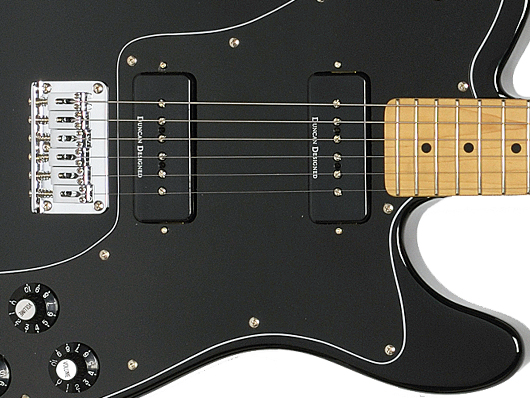
Squier VM Tele Custom II sounds, pros and cons
Sounds
The Custom II is by far the most characterful sounding guitar of our quartet and the second you plug in, there’s no doubt you’re playing a Telecaster. The Duncan Designed singlecoils deliver a wonderful spank, backed by a punching blend of sweet mids and tight bass, which is sheared by the bright nature of the thick maple neck.
In short it has a notably grown-up tonal quality for a guitar of such modest cost.
Under heavier gain, the Custom II misses the earthy thud that the mahogany-based PRS and Vintage deliver. However, it’s nevertheless a cutting and more-ish Tele sound that comes close to Tom Morello’s signature sonics or a plethora of classic rock tones. Again, single-coil hum is clearly there, especially with heavier gain, but in a live scenario it won’t disturb the fun when you’re wailing loud with a rocking band.
Bridge pickup demo:
Pros: Classic Tele looks; build quality; Tele tones; amazing value for money.
Cons: Nothing.
4.5 out of 5
Verdict: The Tele Custom II is the epitome of value with a great Fender feel. Beefed-up Tele tones and that classic Keef look.
Next: Vintage AV1P ‘Special’ price and spec
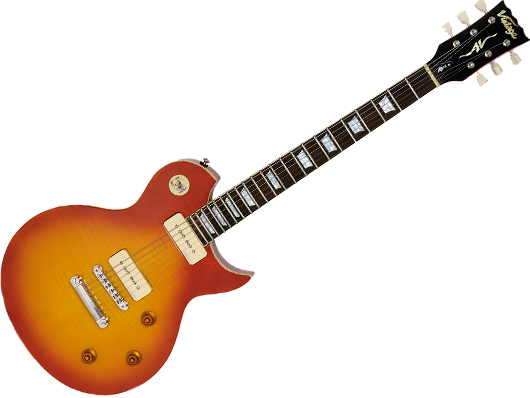
Vintage AV1P 'Special' price and spec
Spec
Price: £429
Origin: China
Body: Mahogany body with carved flame maple veneer
Neck: Mahogany set neck 628mm (24.75-inch)
Fingerboard: Bound rosewood, crown inlays, 22 medium jumbo frets
Hardware: Tune-o-matic-style bridge and stud tailpiece, Wilkinson WJ44 tuners
Electrics: Wilkinson W90SKB and W90SKN P-90 stacked humbuckers, one volume, one tone and one ‘roll control’ (humbucker-to-single-coil), three-way toggle pickup selector
Options: The AV1H equipped with humbuckers and flame maple veneer also costs £429
Finishes: Flame honeyburst (as reviewed) and gold top
Next: Vintage AV1P ‘Special’ build and features
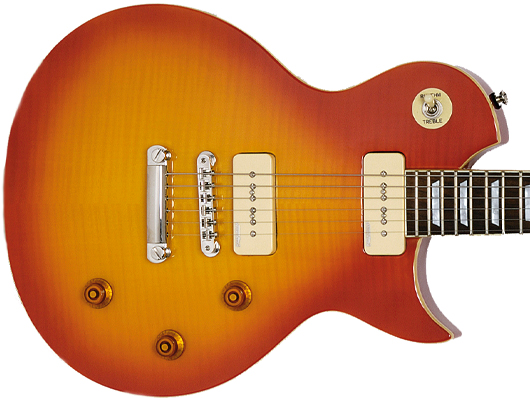
Vintage AV1P 'Special' build and features
Build and features
The Vintage AV1P is part of Vintage’s Advanced series and features clever design tweaks and Wilkinson hardware. Its body is two-piece mahogany, with a subtle flame maple veneer, and is slightly slimmer than a Les Paul thanks to a deep belly scoop and top-edge waist contouring.
The angled top-cutaway isn’t just for visual effect, it offers excellent upper fret access, while a batwing-style neck join provides ample palm comfort.
Pickups are Wilkinson stacked soapbars, with a roll control for graduation from single-coil to ’bucker. We also get Wilkinson Deluxe tuners, tune-o-matic-style bridge and stud tailpiece.
The AV1P plays as well as any of our quartet; the mahogany neck and rosewood fretboard embodies that classic Gibson sixties slinky feel. The finishing is a little untidy but these purely cosmetic issues don’t manage to take the shine away from an otherwise delightful instrument.
Next: Vintage AV1P ‘Special’ sounds, pros and cons
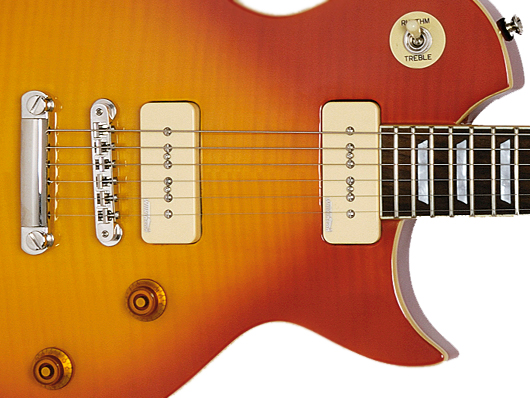
Vintage AV1P 'Special' sounds, pros and cons
Sounds
Tonally, the AV1P is a little more rounded in the top end than the PRS and the mids are fuller. Played clean, the AV1P demonstrates an almost Tele-like character, especially when picking nearer the bridge, which adds extra bite to country riffs or choppy indie.
Under ample gain, the AV1P is very transparent; the overall tonal quality remains and offers a really interesting blues-rock alternative to a humbucker-equipped LP-style guitar. The roll control adds some hum, even on the full ’bucker selection, though it does offer some interesting versatility.
The full humbucker setting sounds so sweet we feel no need to thin out the tone, instead reaching for the volume control to tame things when needed.
Bridge pickup demo:
Pros: Distinct looks; Gibson-inspired feel; sweet and varied tones.
Cons: Final fit and finish is below par.
3.5 out of 5
Verdict: The AV1P has great feel, sounds good and is a rewarding experience for reasonable outlay.
Next: The Verdict - which guitar is best?

The Verdict - which guitar is best?
Verdict
From this round-up, it’s clear that there are some gems out there that offer more, to more players, than ever before. Any one of our quartet is worthy of becoming your next gigging guitar, which says a lot for their overall tone and build quality.
The PRS is an ideal example of what a mid-priced Asian-made instrument should be. Quality is ingrained and every detail is meticulously checked. This is the kind of build standard we’ve come to expect from PRS’s SE wing and as the US PRS guitars did when they first hit the US scene in the mid eighties, the SE range is setting the standard for Asian manufacturers.
Did we forget to mention that it sounds cool and comes with a PRS gigbag worth £79 too?
The Ibanez offers noiseless pickups, but also maintains a good classic soapbar tone. The build quality is generally good for the price and though it lacks the out and out tonal character of the Squier or PRS, it still presents a viable alternative for someone wanting something different. It’s a perfectly gigable guitar with a variety of usable, retro-inspired tones.
A tone that belies the price
Overall, the Squier represents the model that offers the best value for money here. The build quality is exceptional for the price, but it’s the tonal quality that this guitar possesses that amazes us. The Duncan Designed single-coils give depth, character and a striking high-end tone that belies its modest price tag. The chunky neck feels great in the palm and, we’d wager, really adds to the overall tone and resonance of the instrument.
The Vintage AV1P is a fine sounding and looking guitar. Its range of tones is surprising, and so is the very vintage-y feel and vibe. Tonally, it isn’t too far away from the PRS, but it’s that extra few percent that makes the difference here: our example had a few cosmetic issues and a rather rough-looking nut job.
However, if you can live with these minor cosmetic issues, you’re left with a great sounding, competitively priced Gibson-inspired guitar that delivers classic P-90 tones with confidence.
Buy from our recommended retailers:
PRS SE Soapbar is currently available from Thomann
Ibanez JTK30H is currently available from Thomann
Vintage AV1P Special is currently available from Hartnoll Guitars
Squier VM Tele Custom II is currently available from Andertons Music Co.
Liked this? Now read: The best electric guitars under £300
Connect with MusicRadar: via Twitter, Facebook and YouTube
Get MusicRadar straight to your inbox: Sign up for the free weekly newsletter